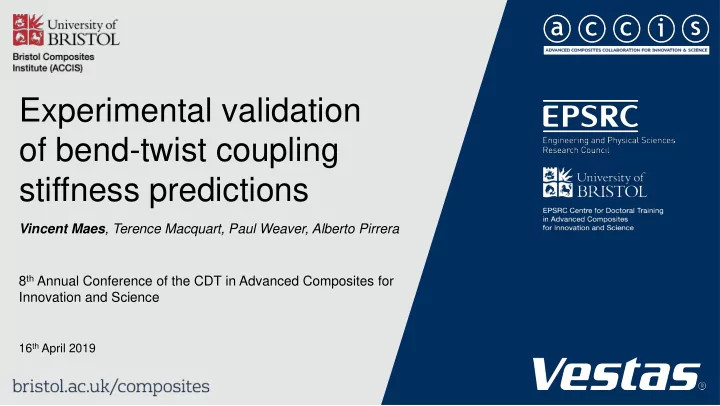

Experimental validation of bend-twist coupling stiffness predictions Vincent Maes , Terence Macquart, Paul Weaver, Alberto Pirrera 8 th Annual Conference of the CDT in Advanced Composites for Innovation and Science 16 th April 2019
2 Overview • Introduction • Numerical Work: • Demonstrator Design • Model Comparison • Experimental Work: • Build & Testing • Results • Conclusions and Future Work
3 Introduction • Literature • Bend-Twist Coupling has demonstrated advantages, • Modelling techniques disagree on performance [1,2]. • Industry • Design remain unchanged, pending validation. 3.
4 Numerical Work: Demonstrator Design • 5 demonstrators: • BECAS, VABS, and 3D FEM shows: • 100% agreement between BECAS and VABS • Primary stiffness coefficients ( 𝑇 44 , 𝑇 66 ) within 1% • Coupling stiffness coefficients ( 𝑇 46 ) within 2.5% • Strong dependence on input handling
5 Numerical Work: Model Comparison • Numerical Studies: • Looking into handling of features as suggested by Saravia et al. [4]. Inner corner Terms Diff. [%] 𝑇 44 326.92E-6 325.30E-6 -0.5 𝑇 66 433.46E-6 432.07E-6 -0.3 𝑇 46 -75.32E-6 -78.91E-6 -4.8 • Tweaking lay-up in corner, differences can be reduced to under 2%
6 Experimental Work: Build & Testing • Built at the NCC out of 913 E glass • Tested at University of Bristol: • Using calibrated inclinometers • Repeated load cycles • Manual displacement loading
7 Experimental Work: Results • Initial testing of first two beams: • Results repeatable and match well, • Material appears less stiff than modelled, • Awaiting material characterization for final validation. 3 Beam (BECAS) 2.5 Shell (FEM) Axial twist [deg] 2 Shell (FEM) w/ Material Knockdown 1.5 BEAM (VABS) 1 Experimental Sets 0.5 Beam (BECAS) w/ Material Knockdown 0 0 0.5 1 1.5 2 Distance along free length of beam [m]
8 Conclusions • Initial numerical studies show good correlation, but: • High sensitivity to model generation/inputs, • Some sensitivity to model simplifications, • Potentially higher sensitivity to manufacturing tolerances. • Demonstrators built and being tested.
9 Future Work • Complete testing campaign: • Confirm material properties • Validate model predictions • Run extended numerical studies: • Further calibration of modelling techniques • Assessing sensitivity of stiffness coefficients: • To modelling simplifications, • Manufacturing tolerances.
10 Acknowledgements The authors would like to acknowledge Vestas for their support of this research.
Thank you for listening. Questions? vincent.maes@bristol.ac.uk References: 1. Chen, H., et al., A critical assessment of computer tools for calculating composite wind turbine blade properties . Wind Energy, 2010. 13 : p. 497-516. 2. Lekou, D.J., et al., A Critical Evaluation of Structural Analysis Tools used for the Design of Large Composite Wind Turbine Rotor Blades under Ultimate and Cycle Loading . ICCM20 (Proc.), 2015. 3. Chehouri, A., et al., Review of performance optimization techniques applied to wind turbines. Applied Energy, 2015. 142 : p. 361-388. 4. Saravia, C., et al., On the determination of the mechanical properties of wind turbine blades: Geometrical aspects of line based algorithms . Renewable Energy, 2017. 105 : p. 55-65.
Recommend
More recommend